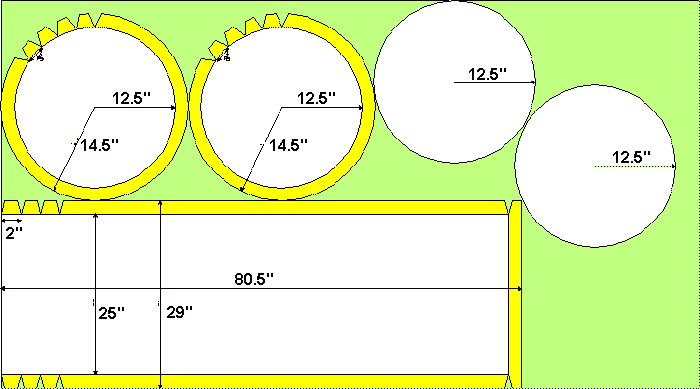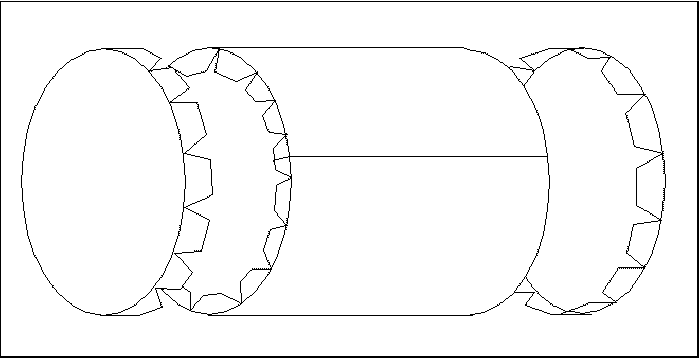

Hi-Lift jacks are a wonderful tool to get out of holes if and when you got stuck. They only have one disadvantage: they can be dangerous! If your truck moves sideways they can move too and the truck can fall off of them.
This can also happen with air-jacks but it is less likely. Air-jacks can be used for almost everything and due to their large “area of attack” they are less likely to cause damage. They can be home made from materials which are easy to obtain and an entire air-jack the size required for the Pinz should not cost more then $30-40.
All you need is a vinyl covered fiberglass material as it is used for canvas tops on trucks (sounds familiar??). The material should be in the 22 to 30 oz/ yd^2 weight area. For a 25” diameter, 25” high air-jack 3 yd of 60” wide material is required.

Layout how the required parts fit into a 3 yd, 60” wide” piece of vinyl canvas.
The perimeter of the two 29” diameter discs has to be “toothed” with a 3” spacing. The same applies to the length sides of the vertical part (outside cover). If you don’t trust your glueing skils make the teeth a bit deeper (i.e.3-4”).
Cut the 5 required pieces and glue (HH-66 glue, follow the instructions and only glue short sections at a time!) the outside to the two 25” disks. Overlap the teeth onto the disc and glue them piece by piece. Make sure that there are no gaps between the teeth and the disc! Do not glue the outside close! You have to be able to reach inside if you want to attach the discs well. Now glue the 29” discs on top of the 25” discs. You only have to apply glue over the teeth of the outside cover. Make sure the discs are centered and the teeth of the 29” discs are 50% offset to the teeth of the outside cover. This makes sure that later on eventual gaps in the seam are closed. Now glue all teeth of the 29” discs over the corner onto the outside cover except the 2 teeth which will go over the seam where the outside cover will be glued together.

Cut the required holes for the filler and deflation hoses and glue them in place. It’s a good idea to glue some scrap pieces of the canvas over the areas the hoses will be attached to.
Now it’s time to glue the outside cover together. The last step is to glue the remaining teeth of the discs over the seam area and you are done.
Filling the air-jack:
opposite to your tires the air-jack need very little pressure (usually 5-10PSI) but lots of volume. It can actually be filled with the exhaust pressure of your engine. However, I believe it’s not a good idea to have all the dirty exhaust gases in the air-jack which is why I would recommend to either use a high volume, low pressure compressor or just wait until the tire inflator has filled the bag up. If you use the tire inflator it is highly recommended to add a safety valve to the hose which opens at a maximum of 16-20PSI. This avoids that you turn your air-jack into a bursting balloon ..............
<legal notice>
Caution! This instruction is only given for educational purposes! I do NOT recommend that you build an airjack according to this page. If you do so you do it on your own risk. In this case please test it before you need it........
</legal notice>
Sources:
Vinyl coated fiberglass: Mauritzon Inc 773-235-6000, it's 61" wide. Talk to Rich and tell him it's for a Hovercraft to get that price. It's called Coverlight Select and comes in Red, Blue, Black and Gray. They also sell the glue you'll need called HH-66 in pints and quarts.
Valves: McMaster, http://www.mcmaster.com
© 2002-2005, K. Juergen Schoepf